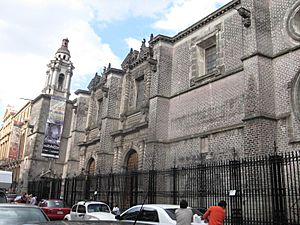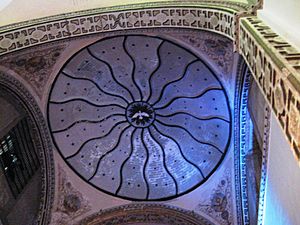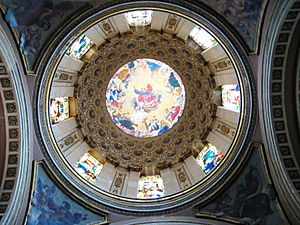Santa Teresa la Antigua facts for kids
Quick facts for kids Santa Teresa la Antigua |
|
|---|---|
| Country | Mexico |
| Denomination | Roman Catholic |
Santa Teresa la Antigua is a historic building in the old center of Mexico City. It's located near the city's main square, the Zocalo. This amazing place used to be a convent, a home for nuns, but it stopped being one in the late 1800s. Since 1989, it has been known as the Santa Teresa la Antigua Alternative Art Center. Here, you can see all kinds of modern and unique art!
Contents
How the Convent Started
A Promise Made at Sea
The idea for this convent began in 1613. An important leader, Archbishop Juan Pérez de la Serna, was on a ship caught in a terrible storm. He was afraid the ship would sink. To save himself, he made a promise to Saint Teresa of Ávila. He promised to build a Carmelite monastery if he reached New Spain (which is now Mexico) safely.
Building the New Convent
Once he was safe on land, the archbishop kept his promise. He convinced two wealthy sisters, Inés Castillet and Mariana de la Encarnación, to help pay for the project. Other rich people also contributed money. Much of the convent was built very quickly, in just eight months! The order of nuns started living there in 1616. It was first called the San José de las Carmelitas Descalzas convent. However, most people knew it as "Santa Teresa la Antigua," meaning "Old Saint Teresa."
Life Inside the Convent
The nuns who lived here followed a very strict way of life. They were part of the Discalced Carmelites tradition from Spain. This meant they lived simply and did not have many servants. Unlike other convents, they only had girls who wanted to become nuns helping them. Most of the building was open to the public, but some areas were just for the nuns.
Changes and Rebuilding Over Time
New Designs and Art
The church part of the convent was rebuilt in 1684. It was officially renamed "Nuestra Señora de la Antigua." Later, in 1813, a large part of the complex was rebuilt by Antonio Gonzalez Velazquez. The chapel of Señor de Santa Teresa was also finished then. Beautiful paintings by a Spanish artist named Rafael Ximeno y Planes were added.
Surviving Earthquakes
Sadly, an earthquake later damaged the church. It destroyed the dome and the back part of the church, along with Ximeno's paintings. It took thirteen years to rebuild! A new dome was built, and new paintings were created by another artist, Juan Cordero.
Famous Residents
A famous writer and nun, Sor Juana Inés de la Cruz, once lived here. But because of her delicate health and the strict rules, she soon moved to another convent. The convent also served as a prison for Josefa Ortiz de Dominguez. She was an important person who helped start the Mexican War of Independence.
From Convent to Art Center
In 1863, the convent was closed down. The building was then used for many different things. It was a military barracks, a school for teachers, and even part of the National University. It also housed a government printing press and financial archives.
Finally, in 1989, the building found its new purpose. It became the Ex-Santa Teresa Alternative Art Center. This center focuses on modern art, including performance art and sculptures. A group dedicated to collecting alternative art was started here in 1993.
Cool Features of the Building
Leaning Facade
If you look closely at the front of the building, you might notice it leans backward a bit. This happens because Mexico City is built on soft soil. Over many years, the building has slowly sunk unevenly into the ground. Strong supports called buttresses divide the facade.
Baroque Style
The convent has two identical entrances that show off Baroque style. Both the first and second floors have columns that look like Solomonic columns (twisted columns). However, the columns on the second floor are actually smooth spirals. The window frame facing the street is very fancy. It has special symbols for the Virgin Mary, Saint Joseph, and Saint Joachim. The outside of the building also has sixteen Corinthian columns and a dome with colorful stained-glass windows.
Amazing Murals
After the building was fixed from an earthquake in 1845, new murals were painted on its walls by Juan Cordero. You can see paintings like "The Christ of Saint Theresa" and "Saint Matthew." Inside the cupola (the dome), above the stained-glass windows, Juan Cordero painted a mural of "God, the Father" surrounded by images that represent good qualities like kindness and honesty.
See also
 In Spanish: Iglesia de Santa Teresa la Antigua para niños
In Spanish: Iglesia de Santa Teresa la Antigua para niños
- List of colonial churches in Mexico City




